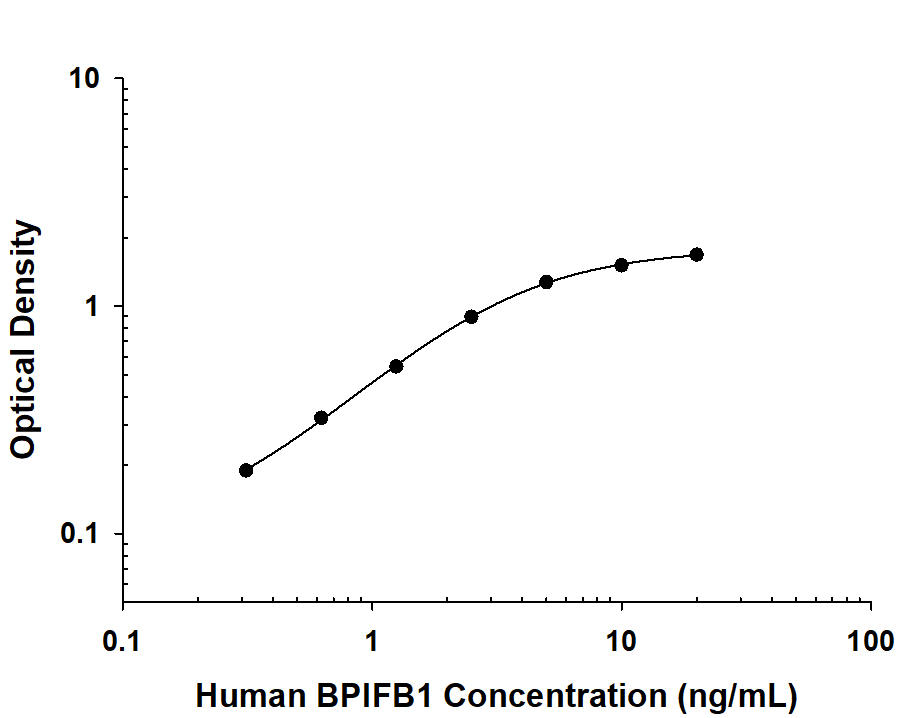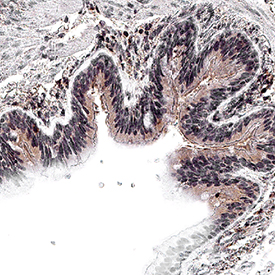Human BPIFB1 Antibody Summary
Thr22-Gln484
Accession # Q8TDL5
Applications
This antibody functions as an ELISA capture antibody when paired with Mouse Anti-Human BPIFB1 Monoclonal Antibody (Catalog # MAB101951).
This product is intended for assay development on various assay platforms requiring antibody pairs.
Please Note: Optimal dilutions should be determined by each laboratory for each application. General Protocols are available in the Technical Information section on our website.
Scientific Data
 View Larger
View Larger
Human BPIFB1 ELISA Standard Curve. Recombinant Human BPIFB1 protein was serially diluted 2-fold and captured by Mouse Anti-Human BPIFB1 Monoclonal Antibody (Catalog # MAB101952) coated on a Clear Polystyrene Microplate (DY990). Mouse Anti-Human BPIFB1 Monoclonal Antibody (MAB101951) was biotinylated and incubated with the protein captured on the plate. Detection of the standard curve was achieved by incubating Streptavidin-HRP (DY998) followed by Substrate Solution (DY999) and stopping the enzymatic reaction with Stop Solution (DY994).
 View Larger
View Larger
BPIFB1 in Human Lung. BPIFB1 was detected in immersion fixed paraffin-embedded sections of human lung cancer using Mouse Anti-Human BPIFB1 Monoclonal Antibody (Catalog # MAB101952) at 15 µg/mL for 1 hour at room temperature followed by incubation with the Anti-Mouse IgG VisUCyte™ HRP Polymer Antibody (VC001). Before incubation with the primary antibody, tissue was subjected to heat-induced epitope retrieval using Antigen Retrieval Reagent-Basic (CTS013). Tissue was stained using DAB (brown) and counterstained with hematoxylin (blue). Specific staining was localized to epithelial cells in bronchioles. Staining was performed using our protocol for IHC Staining with VisUCyte HRP Polymer Detection Reagents.
Reconstitution Calculator
Preparation and Storage
- 12 months from date of receipt, -20 to -70 °C as supplied.
- 1 month, 2 to 8 °C under sterile conditions after reconstitution.
- 6 months, -20 to -70 °C under sterile conditions after reconstitution.
Background: BPIFB1
BPIFB1 (BPI fold-containing family B member 1), also named LPLUNC1, is a member of the BPI-fold (BPIF) containing/Plunc (palate, lung, and nasal epithelium clone) superfamily of putative innate defense molecules which are predominantly expressed in regions of the oral cavity, nasopharynx and upper respiratory tract (1, 2). BPIF proteins exist as two subgroups, BPIFA (formally SPLUNCs) and BPIFB (formally LPLUNCs) (1, 3). BPIFA proteins have structural homology to the N-terminal domain of BPI whereas BPIFB proteins have structural homology to both domains of BPI (2). Human BPIFB1 cDNA encodes a 484 amino acid (aa) precursor protein with a putative 21 aa signal peptide and a 463 aa mature chain. The mature human BPIFB1 shares approximately 57% and 56% aa sequence identity with mouse and rat BPIFB1, respectively. BPIF proteins appear to exhibit distinct tissue and cell specific expression patterns with various family members, being localized to a number of glandular structures within the upper respiratory tract, nasopharyngeal regions and oral cavity where they are secreted from these tissues and are found in high levels in saliva and nasal and respiratory lining fluids (2). BPIFB1 plays a role in diverse functions, including neutralizing endotoxin (LPS) in septic shock patients, inhibition of endothelial cell growth, dendritic cell maturation, as an anti-angiogenic, chemoattractant or opsonization agent (2). Although less characterized as BPIFA1, BPIFB1 may also function as an innate immune molecule sensing and responding to Gram-negative bacteria (4). BPIFA1 and BPIFB1 expression was increased in late stage chronic obstructive pulmonary disease (COPD) patients, and elevated levels correlate with disease severity (5). BPIFB1 is also upregulated in cystic fibrosis (CF) lung disease and may play a role in the pathogenesis of the disease (6).
- Bingle, C. D. and C. J. Craven (2002) Hum. Mol. Genet. 11:937.
- Alves, D. B. et al. (2017) Braz. Oral Res. 31:e6.
- Bingle, L. et al. (2012) Histochem. Cell Biol. 138:749.
- Balakrishnan, A. et al. (2013) Innate Immun. 19:339.
- De Smet, E. G. et al. (2017) Int. J. Chron. Obstruct. Pulmon. Dis. 13:11.
- Saferali, A. et al. (2015) Am. J. Respir. Cell. Mol. Biol. 53:607.
Product Datasheets
FAQs
No product specific FAQs exist for this product, however you may
View all Antibody FAQsReviews for Human BPIFB1 Antibody
There are currently no reviews for this product. Be the first to review Human BPIFB1 Antibody and earn rewards!
Have you used Human BPIFB1 Antibody?
Submit a review and receive an Amazon gift card.
$25/€18/£15/$25CAN/¥75 Yuan/¥2500 Yen for a review with an image
$10/€7/£6/$10 CAD/¥70 Yuan/¥1110 Yen for a review without an image

